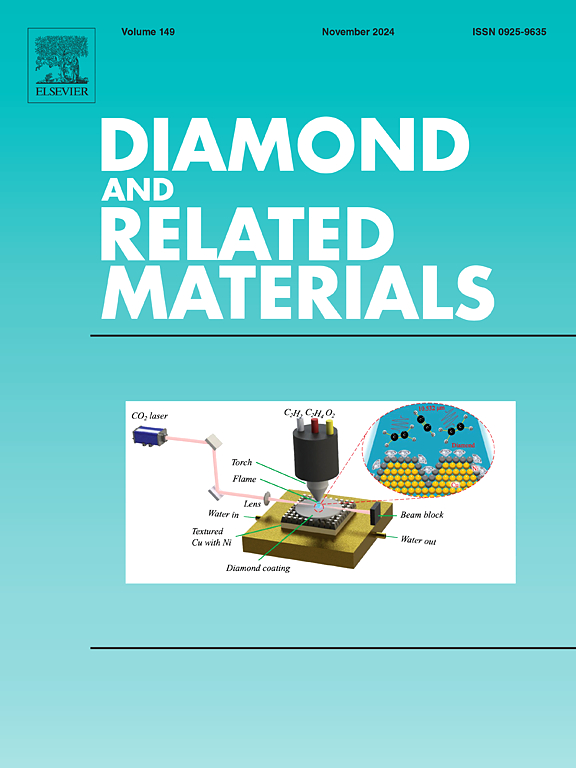基于钼中间层的火花等离子烧结金刚石-铜复合材料扩散键合界面的结构和导热性能
IF 4.3
3区 材料科学
Q2 MATERIALS SCIENCE, COATINGS & FILMS
引用次数: 0
摘要
高效的热传导特性对电子封装材料具有重要意义。金刚石-铜(Cu)复合材料被认为是最有潜力的热管理材料,然而,由于存在粘结界面缺陷和较差的润湿性,材料的导热系数(CTC)降低,限制了材料的应用。采用火花等离子烧结(SPS)扩散连接方法连接金刚石- cu复合材料。在结合界面中加入钼(Mo)中间层后,形成了可靠的结合界面。材料的CTC由658.1 W/(m·K)提高到724.33 W/(m·K),热膨胀系数(CTE)为6.1 × 10−6 K−1,与半导体芯片匹配良好。界面缺陷的减少、成键能力的增强、材料密度的提高增强了材料的导热性,界面处Mo2C的生成增强了界面声子的耦合、电子轨道的杂化,从而增强了界面导热性。该研究为金刚石- cu复合材料界面改性提供了理论支持。本文章由计算机程序翻译,如有差异,请以英文原文为准。

The structure and thermal conductivity of the diffusion-bonded interface of diamond-copper composite material prepared by spark-plasma sintering based on a molybdenum interlayer
An efficient thermal conduction characteristic is significant for electronic packaging materials. The diamond‑copper (Cu) composite material is considered to offer the most potential as a thermal management material, however, the coefficient of thermal conductivity (CTC) of the material is decreased due to the presence of bonded interface defects and the poor wettability, limiting the application of the material. Spark plasma sintering (SPS) diffusion bonding was used to join the diamond-Cu composite material. After adding a molybdenum (Mo) interlayer to the bonded interface, a reliable bonded interface was formed. The CTC of the material increases from 658.1 W/(m·K) to 724.33 W/(m·K), and the coefficient of thermal expansion (CTE) is 6.1 × 10−6 K−1, which matches well with the semiconductor chip. The reduction of interfacial defects, the enhancement of bonding ability, the elevation of material densities enhance the thermal conductivity of the material, the generation of Mo2C at the interface enhances the coupling of phonons at the interface, the hybridization of electron orbitals, and thus the enhancement of interfacial thermal conductivity. The research provides theoretical support for modification of the interface of the diamond-Cu composite material.
求助全文
通过发布文献求助,成功后即可免费获取论文全文。
去求助
来源期刊

Diamond and Related Materials
工程技术-材料科学:综合
CiteScore
6.00
自引率
14.60%
发文量
702
审稿时长
2.1 months
期刊介绍:
DRM is a leading international journal that publishes new fundamental and applied research on all forms of diamond, the integration of diamond with other advanced materials and development of technologies exploiting diamond. The synthesis, characterization and processing of single crystal diamond, polycrystalline films, nanodiamond powders and heterostructures with other advanced materials are encouraged topics for technical and review articles. In addition to diamond, the journal publishes manuscripts on the synthesis, characterization and application of other related materials including diamond-like carbons, carbon nanotubes, graphene, and boron and carbon nitrides. Articles are sought on the chemical functionalization of diamond and related materials as well as their use in electrochemistry, energy storage and conversion, chemical and biological sensing, imaging, thermal management, photonic and quantum applications, electron emission and electronic devices.
The International Conference on Diamond and Carbon Materials has evolved into the largest and most well attended forum in the field of diamond, providing a forum to showcase the latest results in the science and technology of diamond and other carbon materials such as carbon nanotubes, graphene, and diamond-like carbon. Run annually in association with Diamond and Related Materials the conference provides junior and established researchers the opportunity to exchange the latest results ranging from fundamental physical and chemical concepts to applied research focusing on the next generation carbon-based devices.
 求助内容:
求助内容: 应助结果提醒方式:
应助结果提醒方式:


